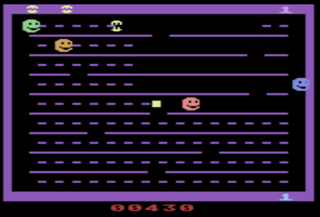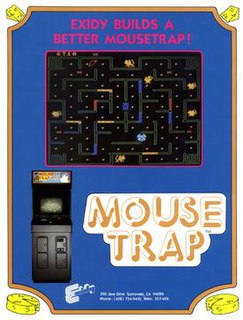 W
W3-Demon is a wire-frame maze game for MS-DOS based on Pac-Man. It was released by PC Research in 1983 as shareware.
 W
W3D Maze Man: Amazing Adventures is a 1998 video game for Microsoft Windows unofficially based on Namco's Pac-Man games and character. In 2000, Pac-Man licensee Hasbro sued to prevent the production and distribution of this and other eGames' other offerings, which included a Tetris-inspired game. Per the settlement, sales continued until the end of September 2000.
 W
WAlien is a 1982 maze video game for the Atari 2600 published by 20th Century Fox. Based on the 1979 film, Alien is a maze game written by Doug Neubauer, but credited in the packaging as "Dallas North." Neubauer is best known for 1979's Star Raiders. Alien for the Atari 2600 is first officially licensed game of the Alien film series.
 W
WLady Bug is an insect-themed maze chase video game produced by Universal Entertainment Corporation and released in arcades in 1981. Its gameplay is similar to Pac-Man, with the primary addition to the formula being gates that change the layout of the maze when used. The arcade original was relatively obscure, but the game found wider recognition and success as a launch title for the ColecoVision console.
 W
WCatChum is a text-only clone of Pac-Man written for the CP/M operating system and made to be operated on the early Kaypro line of luggable computers.
 W
WGobbler is a 1981 clone of Pac-Man for the Apple II, published by On-Line Systems. It was programmed by Olaf Lubeck who also wrote Cannonball Blitz (1982) for the Apple II, a clone of Donkey Kong.
 W
WJawbreaker is a Pac-Man clone programmed by John Harris for the Atari 8-bit family and published by On-Line Systems. Released in 1981 before an official version of Pac-Man was available, it was widely lauded by reviewers, and became a major seller. The story of its creation and Harris's Atari 8-bit implementation of Frogger form a portion of Steven Levy's 1984 book, Hackers: Heroes of the Computer Revolution.
 W
WMunchkin is cartridge number 38 in the official Philips line of games for the Philips Videopac. In North America for the Magnavox Odyssey 2 it was called K.C. Munchkin!, an inside reference to then president of Philips Consumer Electronics Kenneth C. Menkin.
 W
WLady Bug is an insect-themed maze chase video game produced by Universal Entertainment Corporation and released in arcades in 1981. Its gameplay is similar to Pac-Man, with the primary addition to the formula being gates that change the layout of the maze when used. The arcade original was relatively obscure, but the game found wider recognition and success as a launch title for the ColecoVision console.
 W
WMini-Munchman is a handheld electronic game that was released in 1981 in the UK by Grandstand. The game is a rebadged version of Epoch-Man from Epoch. In some markets such as Australia the game was badged "Mini-ARCADE".
 W
WMonster Munch is a clone of Pac-Man programmed by Mark Trotter for the Commodore 64. It was published by Atlantis Software in 1983.
 W
WMouse Trap is a 1981 arcade maze game developed by Exidy. The game design is similar to Pac-Man, replacing Pac-Man with a mouse, the dots with cheese, the ghosts with cats, and the power pellets with bones. The unique element of Mouse Trap is that color-coded doors in the maze can be toggled by pressing a button of the same color.
 W
WMunch Man is a video game written by Jim Dramis for the Texas Instruments TI-99/4A home computer and published as a cartridge by Texas Instruments in 1982. Based on Namco's Pac-Man, Munch Man includes several variations that alter gameplay. Dramis later wrote Parsec for the TI-99/4A. The game cartridge originally sold for $39.95 (USD).
 W
WMunchman is a tabletop electronic game that was released under licence in 1981 in the UK by Grandstand. It is a rebadged version of the Tomy game known as Pac Man in the United States and Puck Man in Japan.
 W
WOh Shit! is a Pac-Man clone originally developed in 1984 for the ZX Spectrum by The ByteBusters and published by Dutch publisher Aackosoft under the Classics range of games; a range that consists of clones of arcade games, i.e Scentipede being a clone of Atari's Centipede. Oh Shit!'s level and art design is identical to that of Pac-Man.
 W
WPoly Play is an arcade cabinet developed in East Germany in 1985; it is the only such machine to originate in the GDR. It was created by VEB Polytechnik and contained a number of games, including a Pac-Man clone.
 W
WScarfman is a clone of Pac-Man written by Philip A. Oliver for the TRS-80 computer and published by The Cornsoft Group in 1981. A version for the TRS-80 Color Computer followed in 1982 as Color Scarfman, which uses 64x64 low resolution graphics.
 W
WSnack Attack is a video game created by Dan Illowsky for the Apple II family of computers and published by Datamost in 1982. The gameplay is very similar to those of Pac-Man, which was released two years earlier.
 W
WSnapper is a clone of the Namco arcade game Pac-Man programmed by Jonathan Griffiths for the BBC Micro and released as one of the launch titles for Acornsoft in 1982. It was also one of Acornsoft's launch titles for the Acorn Electron in 1983.
 W
WSpectre is a video game for the Apple II written by Bob Flanagan and Scott Miller and published by Datamost in 1982.
 W
WTaxman is a clone of Namco's Pac-Man written by Brian Fitzgerald for the Apple II and published by H.A.L. Labs, a firm he cofounded with Greg Autry, in 1981.